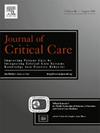New prognostic score for mortality in critically ill patients. Development and validation
IF 2.9
3区 医学
Q2 CRITICAL CARE MEDICINE
引用次数: 0
Abstract
Objective: To develop and validate a novel prognostic model to predict mortality in critically ill patients admitted to the ICU. Unlike APACHE II the new model incorporates risk factors assessed throughout the entire ICU stay, allowing for a more comprehensive evaluation and a better understanding of how the probability of mortality changes. Design: Post-hoc analysis of multicenter, prospective data from 167 Spanish hospitals (193 ICUs) collected over 7 years. Patients: Adults (>18 years). Interventions: Demographic and clinical variables were analyzed. The model was developed using multivariable logistic regression in an estimation group and validated using a separate cohort. Variables of Interest: The primary outcome was ICU mortality, which was clearly defined and analyzed in both the model development and validation phases. The model incorporated APACHE II and eight additional factors evaluated across the entire ICU stay: prior antibiotic use (48 h pre-ICU), hospitalization days before ICU, hematologic diagnoses, invasive mechanical ventilation, parenteral nutrition, shunt ventricular, renal clearance techniques, and infections associated with invasive devices leading to sepsis. Results: Of the 137,666 patients, 91,777 were assigned to the estimation group and 45,889 to validation. Mortality was 10.8 %, strongly associated with APACHE II severity. The new model demonstrated superior discriminatory ability (AUROC = 0.872) compared to APACHE II alone (AUROC = 0.826) and it improved reclassification by 52 % over APACHE II: 19.4 % of survivors and 32.75 % of non-survivors. This improvement, though numerically modest, has clinical relevance by enhancing risk stratification and guiding interventions. Conclusions: A validated NMP model was developed using nine additional risk factors alongside APACHE II.
危重病人死亡率的新预后评分。开发和验证
目的:建立并验证一种新的预测ICU重症患者死亡率的预后模型。与APACHE II不同,新模型纳入了整个ICU住院期间的风险因素评估,允许更全面的评估和更好地了解死亡概率如何变化。设计:对167家西班牙医院(193个icu) 7年来收集的多中心前瞻性数据进行事后分析。患者:成人(18岁)。干预措施:分析人口统计学和临床变量。该模型在估计组中使用多变量逻辑回归建立,并使用单独的队列进行验证。感兴趣的变量:主要结局是ICU死亡率,在模型开发和验证阶段对其进行了明确定义和分析。该模型纳入了APACHE II和整个ICU住院期间评估的八个额外因素:先前使用抗生素(ICU前48小时),ICU前住院天数,血液学诊断,有创机械通气,肠外营养,分流室,肾脏清除技术,以及与侵入性设备相关的感染导致败血症。结果:在137,666例患者中,91,777例被分配到估计组,45,889例被分配到验证组。死亡率为10.8%,与APACHE II严重程度密切相关。与单独的APACHE II相比,新模型显示出更好的区分能力(AUROC = 0.872),并且比APACHE II提高了52%的再分类:19.4%的幸存者和32.75%的非幸存者。这一改善,虽然数字上不大,但通过加强风险分层和指导干预措施具有临床意义。结论:一个经过验证的NMP模型与APACHE II一起使用了9个额外的危险因素。
本文章由计算机程序翻译,如有差异,请以英文原文为准。
求助全文
约1分钟内获得全文
求助全文
来源期刊

Journal of critical care
医学-危重病医学
CiteScore
8.60
自引率
2.70%
发文量
237
审稿时长
23 days
期刊介绍:
The Journal of Critical Care, the official publication of the World Federation of Societies of Intensive and Critical Care Medicine (WFSICCM), is a leading international, peer-reviewed journal providing original research, review articles, tutorials, and invited articles for physicians and allied health professionals involved in treating the critically ill. The Journal aims to improve patient care by furthering understanding of health systems research and its integration into clinical practice.
The Journal will include articles which discuss:
All aspects of health services research in critical care
System based practice in anesthesiology, perioperative and critical care medicine
The interface between anesthesiology, critical care medicine and pain
Integrating intraoperative management in preparation for postoperative critical care management and recovery
Optimizing patient management, i.e., exploring the interface between evidence-based principles or clinical insight into management and care of complex patients
The team approach in the OR and ICU
System-based research
Medical ethics
Technology in medicine
Seminars discussing current, state of the art, and sometimes controversial topics in anesthesiology, critical care medicine, and professional education
Residency Education.
 求助内容:
求助内容: 应助结果提醒方式:
应助结果提醒方式:


